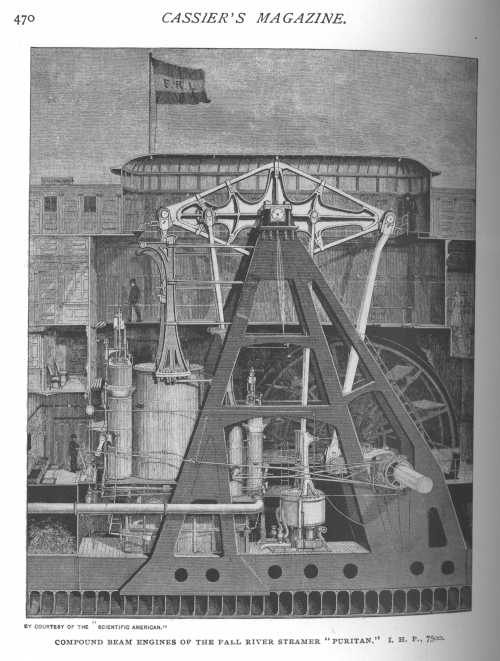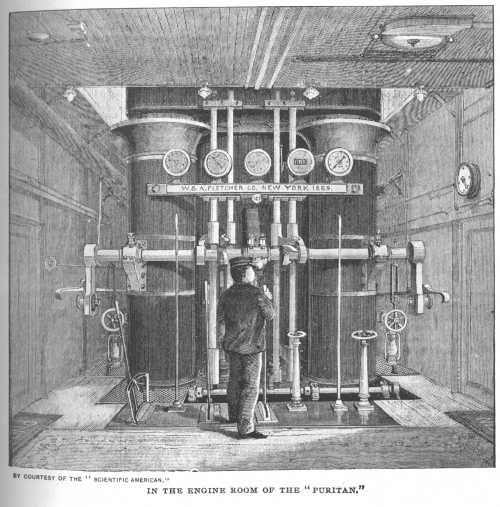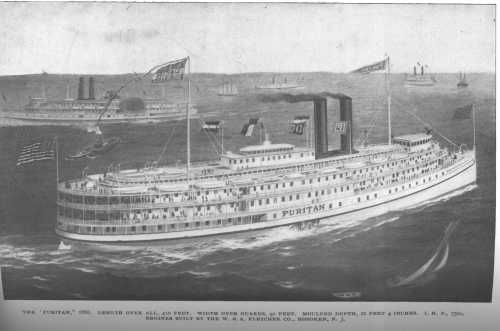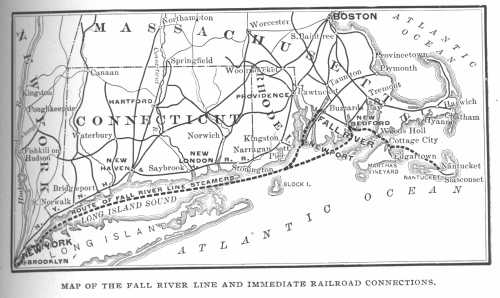
(Page 470)
These are illustrations from the 1897 "Marine Number" of Cassier's Magazine of the compound beam engine of the 1888 paddle steamer Puritan employed by the Fall River line in operation in Long Island Sound. I scanned them from the original in 2000.
The text says the following about this steamer and its engines:
[Page 473] In July, 1888, the steamboat Puritan
was launched, taking her place in the
Fall River Line in June, 1889. She is
yet larger than the Pilgrim, of greater
power, and has a still more complete
equipment.
In building these boats, many and
apparently conflicting requirements ap-
pear, or needs arise which are difficult
to answer. If they left New York late
in the evening, passengers would come
on board and go to bed; that could be
provided for, but these steamboats leave
New York in the afternoon and people
want to be outside, looking at all that
can be seen of the harbour. The then
Duke of Sutherland, when on board the
steamer Bristol, in 1881, suggested that
greater provision for outdoor observ-
ation might be desirable, and the idea
[second column starts here]
was acccepted and developed in the Pur-
itan, on which steamer the upper deck
is made a promenade entirely around
the dome deck, so tthat there is room to
stand while looking about, and a walk
of about 700 feet around the deck from
starting to returning point.
The Puritan has a compound beam
engine, with a high-pressure cylinder,
75 inches in diameter, and 9 feet stroke
of piston. The low-pressure cylinder
is 110 inches in diameter, and has a 14
foot stroke of piston. A surface con-
denser is placed directly under both cyl-
inders, and is supplied with condensing
water by two independent centrifugal
circulating pumps. The air pump is
single-acting, and is connected to the
main connecting rod, that is to say, at
the end opposite that to which the cyl-
inders are connected.
The connecting rod is made especially
heavy and, with the air pump, forms a
balance for the high and low-pressure
pistons and their connections.
The paddle wheels are feathering, 35
feet in diameter outside of the buckets.
The buckets are curved steel plates, 14
feet long and 5 feet wide. Care through-
out was taken in designing the engine, so
[page 473 ends here; page 474 is an illustration of a different boat; text continues on page 475]
that it should be as free from derange-
ment as possible, and the wheels were
accordingly made very strong. Weigh-
ing as they do, independent of the
shafts, 100 tons each, they may be
looked upon as exceptional fly-wheels.
There are eight return tubular boilers
of the Redfield style, having an aggre-
gate of 850 sqaure feet of grate, and
26,000 square feet of heating surface.
The machinery of the Puritan was
designed to indicate 7500 horse-power,
but in regular business this figure is
rarely reached, six of the boilers being
all that are ordinarily used. In fact, on
one occasion only has the boat been run
with the designed power for any length
of time. On this occasion, May 26,
1893, the Puritan, on her way from
New York to Newport, ran down the
Sound with all her boilers in use.
The distance from Stratford Shoal light-
house to the whistling buoy off Point
[second column starts here]
Judith, 87 1/2 statute miles, was made in
4 hours and 2 minutes (giving a speed
of 21 5/8 miles an hour), the engine mak-
ing an average of 22 8-10 [sic] revolutions
per minute, and developing 7700 horse-
power. The tide was flood (against
boat) to Little Gull lighthouse, 53 miles,
and ebb (in favour) the rest of the way
to Point Judith.
Probably the engine of the Puritan
is the largest in the world; that is to
say, no other engine develops as much
power through one pair of cranks, and
to watch these nine-ton cranks with the
two shafts, each about forty tons, and
the wheels (as already stated each 100
tons) making twenty-three revolutions
per minute, with a regularity and
smoothness unexcelled, is certainly very
impressive.
The following discussion explains why the later ship of the Fall River Line, the Priscilla, did not employ beam engines as did the Puritan.
[Page 478] There is probably no better sea boat
than the Puritan. The general distri-
bution of weights with her model makes
her perfectly safe and easy in a seaway.
The additonal weight called for by the
increase in power [of the Priscilla, designed for 8500 hp], and the placing of the
same at even a greater height than on
the Puritan, though in a larger hull,
would decrease the general stability of
the boat. Taking this circumstance into
[second column starts here]
consideration and also the fact that to in-
crease the dimensions of the low-press-
ure cylinder and the working beam of
the Puritan engine would seem almost
impracticable, caused the decision to
change from the beam engine to a style
in which the weights could be placed
lower and the power so divided that
no unusually large parts of machinery
would be necessary.
Later the text has this to say about the builders of the engines:
[page 482] ... The engines for these
[second column starts here] new steamboats were built by the W.
& A. Fletcher Company, of Hoboken,
N. J., the builders of more engines for
steamboats on the Hudson river and
Long Island Sound than any other
company, and whose acquaintance with
this class of work reaches from the
smallest to the largest engine.
Following this, tribute is paid to George Pierce.
[page 482] Many minds laboured with the prob-
lems presented, but all views were fin-
ally subjected to the judgment of Mr.
George Pierce, the constructor and sup-
ervisor of the Fall River Line, and these
boats bear record to his faithful efforts
in accomplishing all that could be
desired.

(Page 470)
The original scan was done at 600dpi, resulting in an image of 3001 x 3971 pixels (7,340,500 bytes when saved in the PNG format). As shown above, the image has been reduced to 500 x 661 pixels and converted to JPEG format. This image is also available as a JPEG in three other resolutions:

(Page 471)
The original scan was done at 600dpi, resulting in an image of 2721 x 2761 pixels (5,558,649 bytes when saved in the PNG format). As shown above, the image has been reduced to 500 x 507 pixels and converted to JPEG format. This image is also available as a JPEG in three other resolutions:

(Page 468)
The original scan was done at 600dpi, resulting in an image of 4241 x 2811 pixels (8,346,056 bytes when saved in the PNG format). As shown above, the image has been reduced to 500 x 331 pixels and converted to JPEG format. This image is also available as a JPEG in one other resolution:

(Page 467)
The original scan was done at 600dpi, resulting in an image of 2731 x 1631 pixels (1,307,550 bytes when saved in the PNG format). As shown above, the image has been reduced to 500 x 298 pixels and converted to JPEG format.
![[George Pierce] Constructor and Supervisor of the Fall River Line.](puritan5-500.jpg)
(Page 481)
The original scan was done at 600dpi, resulting in an image of 1391 x 2301 pixels (1,648,868 bytes when saved in the PNG format). As shown above, the image has been reduced to 500 x 827 pixels and converted to JPEG format. This image is also available as a JPEG in two other resolutions:
This work from the "Marine Number" of
Cassier's Magazine (1897)
is in the public domain.
The reprint of it here is dedicated to the
Public Domain.
Important disclaimers of warranty
and liability in the presentation of public domain material.
The rest of this page is
copyright © 2004 by David M. MacMillan.
This work is licensed under a
Creative Commons License,
which includes important disclaimers of warranty and liability.
lemur.com is a service mark of
David M. MacMillan
and Rollande Krandall.
Other trademark
recognition.
Presented originally by lemur.com.SM